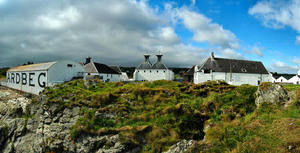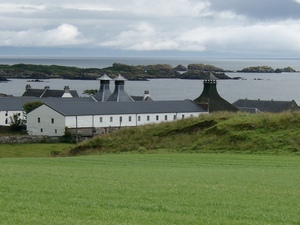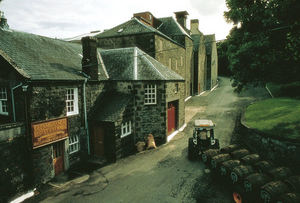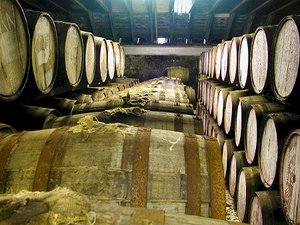|
|
Release Notes
We've turned Ardbeg upside down and inside out
Inspired by a whisky that appears to morph and shift between 4 worlds of flavour, Ardbeg Anamorphic is an enigmatic new whisky - available exclusively to our Committee Members - created using an experimental cask charring technique.
First we remove the cask heads and score them very deeply, in order to expose more surface area of the wood.
Then, we heavily toast them in a very intense, and particularly precise infra-red process. The cask ends are incredibly thick, so they can withstand this concentrated treatment.
Next we expose the casks to flames, aggressively charring the inside of barrels before filling them with glorious Ardbeg new make spirit and trusting them to take care of it whilst it matures...
We've turned Ardbeg upside down and inside out! Tempering those familiar briny overtones, ramping up hidden chocolaty sweetness and magnifying sensations of mocha, this is Ardbeg, but not as we know it.
Inspired by a whisky that appears to morph and shift between 4 worlds of flavour, Ardbeg Anamorphic is an enigmatic new whisky - available exclusively to our Committee Members - created using an experimental cask charring technique.
First we remove the cask heads and score them very deeply, in order to expose more surface area of the wood.
Then, we heavily toast them in a very intense, and particularly precise infra-red process. The cask ends are incredibly thick, so they can withstand this concentrated treatment.
Next we expose the casks to flames, aggressively charring the inside of barrels before filling them with glorious Ardbeg new make spirit and trusting them to take care of it whilst it matures...
We've turned Ardbeg upside down and inside out! Tempering those familiar briny overtones, ramping up hidden chocolaty sweetness and magnifying sensations of mocha, this is Ardbeg, but not as we know it.
Ardbeg
The Distillery: Ardbeg
| Established: 1815 |
| Silent since: False |
| Address: Port Ellen, Isle Of Islay PA42 7DZ, UK |
| → website |
The Ardbeg distillery lies on the South shore of Islay, close to the other "Kildalton" distilleries (Lagavulin and Laphroaig). This coastline is home to some of the scary peat monsters that sometimes keep me up at night...
The 10yo and 17yo "standard" official bottlings are very good and relatively modestly priced . Well, the 17yo is becoming rare these days - no wonder because Ardbeg, like many other distilleries, was silent for a large part of the 1980"s. During most of the 1990"s Ardbeg was very hard to find apart from the odd Gordon & MacPhail bottling, but by the time the new owners had the Ardbeg distillery up and running again Ardbeg was becoming much more widely available, in the form of the new OB"s but as independent bottlings as well.
One relatively new "player" on the market that helped Ardbeg achieve the cult status it has today is Douglas Laing. When they turned their attention from blends to single malts they discovered that they were sitting on a gold mine of casks filled with Ardbeg from the 1970"s. Especially the malts that were distilled in the early 1970"s (before there was a change in production regime) were stunning! I have yet to taste an "official" bottling that can match any of these old "OMC"s" released around the year 2000.
In 1990 Ardbeg joined Allied distillers - but not for long. Glenmorangie bought the distillery in 1997. The purchase and restoration of the distillery required over 10 million British pounds but it turned out to be more than worth it. Helped by clever marketing and solid performance Ardbeg has made a major comeback - rightly so, if you ask me.

If I had to pick one single Islay distillery to supply me with my peaty malts for the rest of my life it would very probably be Ardbeg. Most "deluxe" bottlings have "deluxe" price tags attached to them (even more so after Louis Vuitton took over) but that"s no reason for concern yet.
Ardbeg was officially established as early as 1815, but the distillery probably pre-dates its "commercial" (and legal) start by a decade or two. In 1815 the MacDougall family started production at the site and in 1886 almost a third of all the townsfolk worked at the distillery. In those days the annual production exceeded 300,000 US gallons. Not too shabby!
Unfortunately, the success didn"t last forever. In 1983, less than a century later, the distillery closed. Don"t worry, though - to the relief of peat lovers around the world, production resumed in 1989. The unfanned maltings that gave pre-1989 distillates their unique "espresso style" peatiness remained closed, though.
I wonder what would have happened if Mark Reynier had bought Ardbeg when it became available, like he originally planned. I guess Mark is probably better off with Bruichladdich, the other Islay distillery he bought instead. The lighter style of the Bruichladdich malts has allowed Mark and his team to experiment a lot with the maturing spirit; both the older stocks laid down by the previous ownders as the stuff they distilled themselves since 2001.

With a spirit as powerful as Ardbeg"s, careful cask selection is pretty much all you can do to influence the end result that ends up being bottled as Ardbeg. Of course, a heavily peated spirit becomes drinkable faster than a lighter spirit - well, according to peat freaks that is.
2000 - Due to the closures of the Ardbeg distillery in the 1980"s and 1990"s, official bottlings had been difficult to find during the 1990"s. However, by the start of the new millennium the distillery launched a 10yo official bottling - and for those who wanted to experience even more variety in their Ardbegs, the independent bottlers offered a large selection of single cask bottlings to choose from. These independent releases were often cheaper to boot... (You can find a complete overview of all independent bottlings I tried until 2006 on my Track Record.)
2001 - A new spirit still was installed at Ardbeg and two new official bottlings were released; the Ardbeg 1977 vintage edition and the Ardbeg 25yo "Lord of the Isles".
2005 - Some whisky lovers regard 2005 as a "watershed year" for Ardbeg. During the early noughties one could still find plenty of excellent bottles of Ardbeg at relatively friendly prices, but the launch of the "Ardbeg Serendipity" proved that the new management at Ardbeg was more than happy to milk their customers for all they were worth. They released a "vatting" of Ardbeg and Glen Moray malt whiskies, claiming that it was the result of a mistake at the distillery. Yeah, right... At least it"s a smarter way of introducing a "blended malt" than Diageo did with Cardhu...

2006 - Stuart Thompson (distillery manager at Ardbeg since the take-over by Glenmorangie PLC in 1997) left the distillery after working there for almost a decade. He was later replaced by Michael Heads.
Ardbeg is also a good example of the sometimes very complex structure of ownership in the Scotch malt whisky world.
The owner of Ardbeg distillery is Glenmorangie Plc. - owners of the distilleries Glenmorangie and Glen Moray as well. They are owned by Moët Hennessy, which in turn is owned by the LVMH group (which stands for Louis Vuitton Moët Hennessy) and Diageo (owner over more than two dozen distilleries.
Are you still with me? According to its own web site, the LVMH group is the "world leader in luxury" - and it shows in the prices. Even the most mundane Ardbeg expressions have a "deluxe" price tag these days, making the distillery drop from my list of Top 10 favourite distilleries some time ago.
In the new Millenium
Trivia:
- Casks of Ardbeg whisky are stored at the distillery in four warehouses. Two are of the traditional "dunnage" type while the other two are "racked" warehouses. Together they hold up to 24,000 casks of whisky.
- Ardbeg buys its peated malt from the nearby Port Ellen maltings that also produces the peated malt for most other distilleries on the island according to their exact specifications. The phenolic level of Ardbeg is set at 55 PPM, which is not extremely peaty compared to some other Islay distilleries.
- Official bottlings of Ardbeg released in the late 1990"s were excellent without exception, but it seems that the quality has been slipping since the early noughties. After some other developments (steadily rising prices, the incredible "Serendipity" story, the takeover by "nouveau riche" company Louis Vuitton) this was the last drop that pushed Ardbeg from the upper half of my Top 10 of favourite distilleries a few years ago - and from the list altogether after they started releasing "pimp" expressions like the Ardbeg 1965 and the Double Barrel at insulting prices.
from Malt Maniacs
The Owner: Glenmorangie
| Established: 1843 |
| Silent since: False |
| Address: Glen Morangie, Tain, Ross-Shire IV19 1PZ, United Kingdom |
| → website |
The Glenmorangie distillery in the Northern Highlands of Scotland can be credited with the popularisation of the idea of "finished malt whisky" - although I"m not sure if they were also the first to apply the technique of double maturation in another cask. Around 1995 Glenmorangie released three different " wood finishes" - a Port Finish, a Madeira Finish and a Sherry Finish. Later on some more finished "limited releases" were bottled.
2009 - Glenmorangie distillery is closed altogether in October 2008 so that two pairs of brand new stills can be added to the eight that were already in use. When the doors of the distillery are opened again in March 2009, the production capacity has increased from 4,000,000 litres of alcohol per year to 6,000,000 litres of alcohol per year. Mind you; this is the MAXIMUM capacity - due to the reconstruction and credit crisis actual production is lower.
2008 - Owners LVMH sell Glenmorangie"s "sister distillery" Glen Moray to La Martiniquaise. LVMH has little interest in whisky production itself and wants to focus on building the brands "Ardbeg" and "Glenmorangie".
Production-wise, a lot has changed at Glenmorangie over the years. For one thing, the number of stills was expanded from two to four in 1980, which was also the time they stopped malting their own barley. Glenmorangie managed to survive the whisky crisis of the early 1980"s with flying colours; in 1990 the number of stills was expanded again to a grand total of eight stills.
Those eight stills enable Glenmorangie to produce a whopping four million litres of pure alcohol each year. For a long time a lot of the malt whisky they produced was consumed within Scotland, but now it"s a world wide brand .
But of course, Glenmorangie is more than the premier purveyor of "finished" whiskies in Scotland. Their history started not unlike many of its Scottish competitors - in the nineteenth century. Not far from the site of the Balblair distillery (founded half a century earlier in 1790) William and John Mathesen built the "Morangie" farm distillery in 1843. William had been one of the co-owners of Balblair but apparently he wanted to strike out on his own. The Mathesen brothers selected a site with a long history of illicit distillation; there are claims about whisky distillation in the area as far back as 1738 and even 1703. However, actual production of malt whisky at Glenmorangie didn"t start until November 1849.
In 1887 the Glenmorangie Distillery Company Ltd. was founded and the distillery was rebuilt. In 1918 the distillery was sold to 2 partners; MacDonald & Muir Ltd. and Durham - circa two decades later MacDonald & Muir became full owners. Somewhere along the way, the name of the parent company was changed to Glenmorangie plc by the MacDonald family. They decided to sell the company (that also owned the Ardbeg and Glen Moray distilleries) to LVMH in 2004.

For a few years Glenmorangie was virtually the only malt whisky distillery to use "deviant" casks for the maturation of their stocks, but around the year 2000 more and more whisky distilleries in Scotland started to experiment with unusual casks that had no place in the whisky tradition.
Particularly Bruichladdich and Edradour turned into radical finishing freaks, taking the concept of double maturation further than Glenmorangie ever did. Personally, I prefer some of these "finishes" to the regular product...
During the 1990"s Glenmorangie was one of the few malt whisky distilleries with a well oiled marketing machine behind them, like Glenfiddich, Glenlivet, Springbank and the Classic Malts.
For my own tastes the PR language sometimes was a tad too oily, but you can"t argue with the numbers; Glenmorangie is now a top selling malt.
2004 - Glenmorangie buys the Scotch Malt Whisky Society. Furthermore, on August 24, 2004 the MacDonald family put their majority share of Glenmorangie Group plc on the market. Within the whisky industry, many expected that Brown Forman (owner of brands like Jack Daniels, Woodford Reserve and Southern Comfort) would expand its minority share, but perfume peddlers Louis Vuitton Moet Hennessey took over the company and its three distilleries instead.
2007 - The entire range of official Glenmorangie bottlings is revised. The old 10yo is replaced by the 10yo "Original" and parts of the range are discontinued. This includes the 15yo, the 30yo (which had just been introduced in 2005) and many of the more exotic finishes. The varieties "Astar" and "Signet" are introduced not long afterwards.
After the success the "mother brand" had with finishes, "daughter distillery" Glen Moray started to release their own finishes as well around the year 2000. For me personally, these didn"t work as well as the Glenmorangie finishes. While the fairly clean and subtle regular 10-12yo whisky from Glenmorangie benefited from the extra maturation, the fuller Speyside malts from Glen Moray lost some of their "edge" after weird finishes like Chardonnay or Chenin Blanc.

For my own tastes the PR language sometimes was a tad too oily, but you can"t argue with the numbers; Glenmorangie is now a top selling malt.
But is it any good? Well, the "house style" of most of the regular line-up is a tad light for my own tastes, but for "brand" blend drinkers it is a perfect "gateway malt" - a strong brand they can stick to with a couple of interesting expressions that could lead them to new malty discoveries later on.
As for the finishes: they seem to have a hard time achieving batch consistency, so buying a bottle is Russian roulette... Glenmorangie whisky Glenmorangie distillery in the new millennium
But is it any good? Well, the "house style" of most of the regular line-up is a tad light for my own tastes, but for "brand" blend drinkers it is a perfect "gateway malt" - a strong brand they can stick to with a couple of interesting expressions that could lead them to new malty discoveries later on.
As for the finishes: they seem to have a hard time achieving batch consistency, so buying a bottle is Russian roulette...
After the success the "mother brand" had with finishes, "daughter distillery" Glen Moray started to release their own finishes as well around the year 2000. For me personally, these didn"t work as well as the Glenmorangie finishes. While the fairly clean and subtle regular 10-12yo whisky from Glenmorangie benefited from the extra maturation, the fuller Speyside malts from Glen Moray lost some of their "edge" after weird finishes like Chardonnay or Chenin Blanc.
In the new Millenium
Trivia:
- At a height of more than 16 feet (5 m.), Glenmorangie has the tallest pot stills in the Scotch whisky industry. The original pair was expanded to four in 1980, and doubled again to eight in 1990. A further expansion to a grand total of twelve stills occurred in 2008 and 2009. All stills ore close replica"s from the stills that were built in 1887.
- The Glenmorangie distillery used to be a brewery before the distillery was founded.
- An unusually high percentage of the whisky that is distilled at Glenmorangie is sold as a single malt. Circa 70% of the whisky is bottled as SMSW; the rest was used in blends like Bailie Nicol Jarvie & Highland Queen. The very small percentage of malt whisky that is sold to brokers and bottlers used to be diluted with a few drops of Glen Moray (so it can"t be sold on as a single malt) and labeled as "West Port whisky".
- Glenmorangie has proven that it"s possible to increase sales considerably while decreasing "quality". Since the early 1990"s the profile of the regular expressions had been growing blander and blander, but the changes happened at an even more rapid pace after perfume peddlers Louis Vuitton MH obtained the distillery.
- The name of the whisky is pronounced glen-MOR-an-jee, with the stress on the "mor" and rhyming with orangey, not GLEN-mor-AN-jee as it is commonly mispronounced.
from Malt Madness
The Owner: LVMH Moet Hennessy * Louis Vuitton
| Established: 1987 |
| Silent since: False |
| Address: 22, Avenue Montaigne, 75008 Paris, France |
| → website |
Christian Dior, the luxury goods group, is the main holding company of LVMH, owning 42.4% of its shares, and 58.2% of its voting rights. Bernard Arnault, majority shareholder of Dior, is Chairman of both companies and CEO of LVMH. His successful integration of various famous aspirational brands into the group has inspired other luxury companies into doing the same. Thus Gucci (now part of the French conglomerate PPR) and Richemont have also created extended portfolios of luxury brands. The oldest of the LVMH brands is wine producer Chateau d"Yquem, which dates its origins back to 1593.
LVMH is based in Paris, France. The company is listed on the Euronext Paris exchange, and is a constituent of the CAC 40 index. As of 2008, the group revenues of EUR17.2 billion with a net income of EUR2.318 billion. The group currently employs 77,000 people. 30% of LVMH"s staff work in France. LVMH operates over 2,300 stores worldwide. Its current business plan aims to tightly control the brands it manages in order to maintain and heighten the perception of luxury relating to their products. For example, Louis Vuitton products are sold only through Louis Vuitton boutiques found in upmarket locations in wealthy cities or in concessions in other luxury goods shops (such as Harrods in London). This practice contrasts greatly with less exclusive brands which can be bought in shopping malls around the world.

LVMH Moet Hennessy * Louis Vuitton S.A. (Euronext: MC), usually shortened to LVMH, is a French holding company and one of the world"s largest luxury goods conglomerate. It is the parent of around 60 sub-companies that each manage a small number of prestigious brands. These daughter companies are, to a large extent, run autonomously. The group was formed after mergers brought together champagne producer Moet et Chandon and Hennessy, a leading manufacturer of cognac. In 1987, they merged with fashion house Louis Vuitton to form the current group.
from Wikipedia
